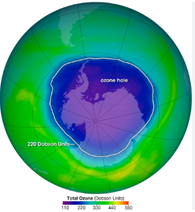TAG: GS 3: ENVIRONMENT
THE CONTEXT: According to a new study, the ozone hole over the Antarctic has not only grown larger but also thinner throughout most of the spring.

EXPLANATION:
- The study published in Nature Communications noted that despite making a recovery in area and depth since the 2000s, the Antarctic ozone hole has been massive in the last four years.
- There is much less ozone in the centre of the ozone hole compared to 19 years ago.
- Concentration of ozone at the center of the ozone hole has reduced, which means the ozone layer has notably thinned.
- The ozone hole is a region of exceptionally depleted ozone in the stratosphere over the Antarctic. It happens at the beginning of the Southern Hemisphere spring from August through October.
- The ozone layer is on track to recover within four decades, according to the United Nations Environment Programme (UNEP).
- The ozone hole has been remarkably large from 2020-22.
- The extent and duration of the 2022 hole were remarkably similar to the large holes of 2020 and 2021.
- Though the analysis included data till 2022, 2023 is also showing the same trend.
- According to NASA, from September 7 to October 13, the hole averaged 23.1 million square kilometers, approximately the size of North America, making it the 16th largest over this period.
- The ozone layer over the Antarctic is intrinsically linked to the climate and dynamics of the Southern Hemisphere.
- The researchers saw a total reduction of 26 per cent at the core of the ozone hole from 2004 to 2022.
- This reduction is despite the 1987 Montreal Protocol on Substances that Deplete ozone layer, which regulates the production and consumption of human-generated chemicals known to deplete the ozone.
- The Montreal Protocol on ozone depleting Substances quadrennial assessment report of 2022 confirmed the phase-out of nearly 99 per cent of banned ozone-depleting substances.
- According to the UNEP, Meteorological conditions could have largely driven fluctuations in the size of the Antarctic ozone hole, from 2019 to 2021,
- It is known that other factors such as springtime temperature and wind patterns, aerosols from wildfires and volcanic eruptions, as well as changes in the solar cycle ozone hole development could also be responsible.
- Lead author from the University of Otago, explained that the Antarctic ozone hole sits within the polar vortex, which is a circular pattern of wind in the stratosphere that forms during winter and is maintained until late spring.
- Within this vortex, the Antarctic air from the mesosphere (the atmospheric layer above the stratosphere) falls into the stratosphere.
- This intrusion of air brings natural chemicals (nitrogen dioxide, for example) which impact ozone chemistry in October.
WHAT IS OZONE HOLE?
- The ozone hole is not technically a “hole” where no ozone is present but is actually a region of exceptionally depleted ozone in the stratosphere over the Antarctic that happens at the beginning of Southern Hemisphere spring (August–October).
Causes:
- The ozone hole, has developed because people have polluted the atmosphere with chemicals containing chlorine and bromine.
- The primary chemicals involved are chlorofluorocarbons (CFCs for short), halons, and carbon tetrachloride.


